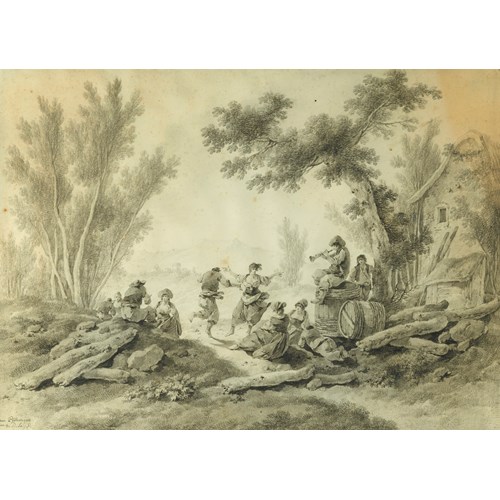Antonio Domenico Gabbiani
The Rape of the Sabine Women
Period 1600-1750, 17th century, 18th century
Origin Italy
Medium Pen, Brown ink, Black chalk
Dimension 24.1 x 33.7 cm (9¹/₂ x 13¹/₄ inches)
The scene captured here by Antonio Gabbiani shows a mass of writhing bodies and Roman soldiers lifting them up. It is perhaps worth noting that the reference to rape in this context comes from the Latin rapio which means ‘to seize’. Livy is very clear on the matter stating that Romulus offered the Sabine women free choice and promised them civic and property rights: ‘They would live in honourable wedlock, and share all their property and civil rights, and - dearest of all to human nature - would be the mothers of free men.’2
The old attribution inscribed on this drawing is a testament to the pervasive influence that Pietro da Cortona’s works exerted on Gabbiani, after he first saw them in Rome. Although his debt to Cortona’s celebrated painting of the same subject, now in the Pinacoteca Capitolina, Rome3, is obvious here, Gabbiani has imbued the composition with his own rhythm and energy. The arms of the women in Cortona’s work owe much to the influence of Bernini, particularly his Apollo and Daphne. Gabbiani takes this on too and the influences of the two are readily apparent.
Carlo Maratti and Pietro da Cortona were both strong influences on Gabbiani, who studied in Florence, Venice, and travelled extensively around Europe. He is chiefly known for his magnificent frescoes for the palazzi of the Italian aristocracy including the Strozzi-Ridolfi (1694), Corsini (1695), and Medici-Riccardi (1690-97) among many others. A large number of preparatory drawings survive for these decorative schemes and can be seen in the Uffizi, Florence.
Gabbiani received a number of commissions from the Medici family including requests to depict religious subjects. His Christ Giving Communion to St. Peter of Alcantara in the Presence of St. Teresa of Avila (1714, Schleissheim, Neues Schloss), which shows the influence of Sebastiano Ricci, was possibly commissioned by Cosimo III for his daughter Anna Maria Luisa de’ Medici. Other religious commissions include those for the Assumption of the Virgin and the Virgin and Child with the Symbols of the Passion (1720-22, Florence, Uffizi). These paintings, and many of his later oeuvres, reflect both the work of Sebastiano Ricci and the classicism of Maratti.
1 Livy, The History of Rome 1.9.
2 Livy, The History of Rome 1.9.
3 Anna Lo Bianco, et al., Pietro da Cortona, exhibition catalogue, Rome, Palazzo Venezia, 1997-98, no. 36.
Period: 1600-1750, 17th century, 18th century
Origin: Italy
Medium: Pen, Brown ink, Black chalk
Signature: Bears inscription in pen and brown ink: ‘P . Berretini’
Dimension: 24.1 x 33.7 cm (9¹/₂ x 13¹/₄ inches)
Provenance: Sale, London, Sotheby's, 13 December 1973, lot 29 (as Ciro Ferri);
Herbert List (bears his collector's dry stamp twice, not in Lugt);
Flavia Ormond Fine Arts, London;
from whom acquired in 2000 by Jeffrey E. Horvitz.
Literature: C. Monbeig Goguel, Dessins Toscans XVIe-XVIIe Siècles 1620-1800, vol. II, Paris 2005, p. 260, under cat. no. 340
More artworks from the Gallery









